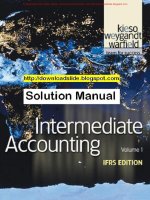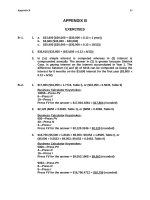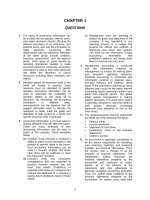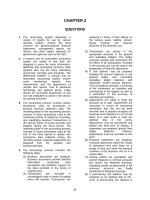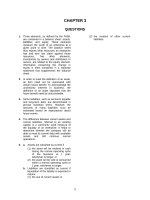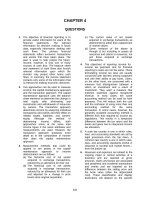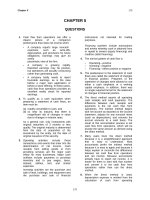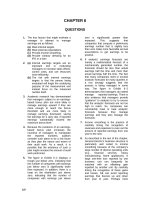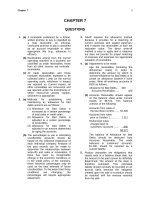Solution manual intermediate accounting 7th by nelson spiceland ch12
Bạn đang xem bản rút gọn của tài liệu. Xem và tải ngay bản đầy đủ của tài liệu tại đây (690.25 KB, 72 trang )
Find more slides, ebooks, solution manual and testbank on www.downloadslide.com
Chapter 12
Investments
QUESTIONS FOR REVIEW OF KEY TOPICS
Question 12-1
Investment securities are classified as “held-to-maturity,” “available-for-sale,” or “trading
securities.”
Question 12-2
Increases and decreases in the market value between the time a debt security is acquired and the
day it matures to a prearranged maturity value are ignored for securities classified as “held-tomaturity.” These changes aren’t important if sale before maturity isn’t an alternative, which is the
case if an investor has the “positive intent and ability” to hold the securities to maturity.
Question 12-3
The fair value of an equity security is considered “readily determinable” if its selling price (or
bid-and-asked quotation) is currently available on a securities exchange. When its fair value is not
readily determinable, an investment is carried and reported at cost. Any dividends received are
recognized as investment revenue, and a gain or loss is reported only when actually realized through
the sale of the investment.
Question 12-4
For investments to be held for an unspecified period of time, fair value information is more
relevant than for investments to be held to maturity. Changes in fair values are less relevant if the
investment is to be held to maturity because sale at that fair value is not an option. The investor
receives the same contracted interest payments and principal at maturity, regardless of movements in
market values. However, when the investment is of unspecified length, changes in fair values
indicate management’s success in deciding when to acquire the investment and when to sell it, as
well as the propriety of investing in fixed-rate or variable-rate securities and long-term or short-term
securities.
Question 12-5
The way unrealized holding gains and losses are reported in the financial statements depends on
whether the investments are classified as “securities available-for-sale” or as “trading securities.”
Securities available-for-sale are reported at fair value, and resulting holding gains and losses are not
included in the determination of income for the period. Rather, they are reported as a separate
component of shareholders’ equity, as part of Other comprehensive income.
Question 12-6
Comprehensive income is a more expansive view of the change in shareholders’ equity than
traditional net income. It encompasses all changes in equity from nonowner transactions. So, in
addition to net income, comprehensive income includes up to four other changes in equity: Net
unrealized holding gains (losses) on investments, Net unrecognized loss on pensions, Deferred gains
(losses) from derivatives, and Gains (losses) from foreign currency translation.
© The McGraw-Hill Companies, Inc., 2007
Solutions Manual, Vol. 1, Chapter 12
12-1
Find more slides, ebooks, solution manual and testbank on www.downloadslide.com
Answers to Questions (continued)
Question 12-7
Unrealized holding gains or losses on trading securities are reported in the income statement as if
they actually had been realized. Trading securities are actively managed in a trading account with the
express intent of profiting from short-term market price changes. So, any gains and losses that result
from holding securities during market price changes are suitable measures of success or lack of
success in achieving that goal.
On the other hand, unrealized holding gains or losses on securities available-for-sale are not
reported in the income statement. By definition, these securities are not acquired for the purpose of
profiting from short-term market price changes, so gains and losses from holding these securities
while prices change are not considered relevant performance measures to be included in earnings.
Question 12-8
Apparently, the drop in the market price of the stock is an other-than-temporary impairment. So,
when the investment is written down to its fair value, the amount of the write-down should be treated
as if it were a realized loss, meaning the loss is included in income for the period. Subsequent to the
other-than-temporary write-down, the usual treatment of unrealized gains or losses should be
resumed. Therefore, later changes in fair value will be reported as a separate component of
shareholders’ equity, accumulated other comprehensive income.
Question 12-9
When acquired, debt and equity securities are assigned to one of the three reporting
classifications – held-to-maturity, available-for-sale, or trading. The appropriateness of the
classification is reassessed at each reporting date. A reclassification should be accounted for as
though the security had been sold and immediately reacquired at its fair value. Any unrealized
holding gain or loss should be accounted for in a manner consistent with the classification into
which the security is being transferred. Specifically, when a security is transferred:
1. Into the trading category, any unrealized holding gain or loss should be recognized in earnings
of the reclassification period.
2. Into the available-for-sale category, any unrealized holding gain or loss should be recorded as
a separate component of shareholders’ equity, Other comprehensive income.
3. Into the held-to-maturity category, any unrealized holding gain or loss should be amortized
over the remaining time to maturity.
Question 12-10
Yes. Although a company is not required to report individual amounts for the three categories of
investments – held-to-maturity, available-for-sale, or trading – on the face of the balance sheet, that
information should be presented in the disclosure notes. The following also should be disclosed for
each year presented: aggregate fair value, gross realized and unrealized holding gains, gross realized
and unrealized holding losses, the change in net unrealized holding gains and losses, and amortized
cost basis by major security type. In addition, information about maturities should be reported for
debt securities, by disclosing the fair value and cost for at least 4 maturity groupings: (a) within 1
year, (b) after 1 year through 5 years, (c) after 5 years through 10 years, and (d) after 10 years.
© The McGraw-Hill Companies, Inc., 2007
12-2
Intermediate Accounting, 4e
Find more slides, ebooks, solution manual and testbank on www.downloadslide.com
Answers to Questions (continued)
Question 12-11
The equity method is used when an investor can’t control, but can “significantly influence” the
investee. If effective control is absent, the investor still might be able to exercise significant
influence over the operating and financial policies of the investee if the investor owns a large
percentage of the outstanding shares relative to other shareholders. By voting those shares as a
block, the investor often can sway decisions in the direction desired. We presume, in the absence of
evidence to the contrary, that the investor exercises significant influence over the investee when it
owns between 20% and 50% of the investee's voting shares.
Question 12-12
The equity method, like consolidation, views the investor and investee as a special type of single
entity. By the equity method, though, the investor doesn’t include separate financial statement items
of the investee on an item-by-item basis as in consolidation. Rather, by the equity method, the
investor reports its equity interest in the investee as a single investment account. That single
investment account is periodically adjusted to reflect the effects of consolidation, without actually
consolidating financial statements.
Question 12-13
The investor should account for dividends from the investee as a reduction in the investment
account. Since investment revenue is recognized as the investee earns it, it would be inappropriate
to again recognize revenue when earnings are distributed as dividends. Rather, the dividend
distribution is considered to be a reduction of the investee’s net assets, indicating that the investor’s
ownership interest in those net assets declines proportionately.
Question 12-14
The equity method attempts to approximate the effects of accounting for the purchase of the
investee as a consolidation. Consolidated financial statements report acquired net assets at their fair
values. Both investment revenue and the investment would be reduced by the negative income
effect of the “extra depreciation” the higher fair value would cause. This would equal 40% x $12
million ÷ 10 years = $480,000 each year for ten years.
Question 12-15
The investment account was decreased by $40,000 (40% x $100,000). Cash increased the same
amount. There is no effect on the income statement.
© The McGraw-Hill Companies, Inc., 2007
Solutions Manual, Vol. 1, Chapter 12
12-3
Find more slides, ebooks, solution manual and testbank on www.downloadslide.com
Answers to Questions (concluded)
Question 12-16
When it becomes necessary to change from the equity method to another method, no adjustment
is made to the carrying amount of the investment. The equity method is simply discontinued and the
new method is applied from then on. The investment account balance when the equity method is
discontinued would serve as the new “cost” basis for writing the investment up or down to market
value in the next set of financial statements.
Question 12-17
A financial instrument is: (a) cash, (b) evidence of an ownership interest in an entity, (c) a
contract that (1) imposes on one entity an obligation to deliver cash or another financial instrument
and (2) conveys to a second entity a right to receive cash or another financial instrument, or (d) a
contract that (1) imposes on one entity an obligation to exchange financial instruments on potentially
unfavorable terms and (2) conveys to a second entity a right to exchange other financial instruments
on potentially favorable terms. Accounts payable, bank loans, and investments in securities are
examples.
Question 12-18
These instruments “derive” their values or contractually required cash flows from some other
security or index.
Question 12-19
Since this fund won’t be used within the upcoming operating cycle, it is a noncurrent asset. It
should be reported as part of “Investments and funds.”
Question 12-20
Part of each premium payment the company makes is not used by the insurance company to pay
for life insurance coverage, but rather is “invested” on behalf of the insured company in a fixedincome investment. As a result, the periodic insurance premium should not be expensed in its
entirety; an appropriate portion should be recorded instead as a noncurrent asset – cash surrender
value.
Question 12-21
When a creditor’s investment in a receivable becomes impaired, due to a troubled debt
restructuring or for any other reason, the receivable is re-measured based on the discounted present
value of currently expected cash flows at the loan’s original effective rate (regardless of the extent to
which expected cash receipts have been reduced). The extent of the impairment is the difference
between the carrying amount of the receivable (the present value of the receivable’s cash flows prior
to the restructuring) and the present value of the revised cash flows discounted at the loan’s original
effective rate. This difference is recorded as a loss at the time the receivable is reduced.
© The McGraw-Hill Companies, Inc., 2007
12-4
Intermediate Accounting, 4e
Find more slides, ebooks, solution manual and testbank on www.downloadslide.com
BRIEF EXERCISES
Brief Exercise 12-1
(a)
Investment in bonds (face amount) .......................
Discount on bond investment (difference) ........
Cash (price of bonds).........................................
720,000
Cash (1.5% x $720,000) ........................................
Discount on bond investment (difference)............
Interest revenue (2% x $600,000) ..........................
10,800
1,200
120,000
600,000
(b)
12,000
Brief Exercise 12-2
Investment in Disney common shares ..........
Cash ([2,000 shares x $27] + $900) ..................
54,900
Cash ([2,000 shares x $29] – $950) ......................
Gain on sale of investments .......................
Investment in Disney common shares .......
57,050
54,900
2,150
54,900
Brief Exercise 12-3
Securities available-for-sale are reported at fair value, and resulting holding gains
and losses are not included in the determination of income for the period. Rather, they
are reported as a separate component of shareholders’ equity, as part of Other
comprehensive income. The adjusting entry needed to increase the fair value
adjustment from $110,000 to $170,000 is:
Fair value adjustment ($670,000 – 610,000)......
Accumulated unrealized holding gains and losses
60,000
60,000
© The McGraw-Hill Companies, Inc., 2007
Solutions Manual, Vol. 1, Chapter 12
12-5
Find more slides, ebooks, solution manual and testbank on www.downloadslide.com
Brief Exercise 12-4
These are securities available-for-sale and are reported at their fair value,
$4,000,000. We know this because securities “held-to-maturity” are debt securities an
investor has the “positive intent and ability” to hold to maturity. Actively traded
investments in debt or equity securities acquired principally for the purpose of selling
them in the near term are classified as “trading securities.” The FedEx shares have
been held for over a year. They are classified as “available-for-sale” since all
investments in debt and equity securities that don’t fit the definitions of the other
reporting categories are classified this way. Of course, the equity method isn’t
appropriate either because 40,000 shares of FedEx certainly don’t constitute
“significant influence.” Investments in securities available-for-sale are reported at fair
value.
Brief Exercise 12-5
Unlike for securities available-for-sale, unrealized holding gains and losses for
trading securities are included in earnings. S&L reports its $2,000 holding loss in
2006 earnings. When the fair value rises by $7,000 in 2007, that amount is reported in
2007 earnings. S&L’s journal entries for these transactions would be:
2006
December 27
Investment in Coca Cola shares .........................................
Cash ...............................................................................
875,000
December 31
Unrealized holding loss ......................................................
Investment in Coca Cola shares ([$875,000 - $873,000)......
2,000
875,000
2,000
2007
January 3
Cash (selling price)................................................................
Gain on investments (to balance) ......................................
Investment in Coca Cola shares (account balance) .............
880,000
7,000
873,000
© The McGraw-Hill Companies, Inc., 2007
12-6
Intermediate Accounting, 4e
Find more slides, ebooks, solution manual and testbank on www.downloadslide.com
Brief Exercise 12-6
Unlike for trading securities, unrealized holding gains and losses for securities
available-for-sale are not included in earnings. S&L reports its $2,000 holding loss in
2006 as Other comprehensive income, a negative component of shareholders’ equity,
not earnings. When the fair value rises to $880,000 in 2007, the amount is reported in
2007 earnings is the $5,000 gain realized by the sale of the securities. S&L’s journal
entries for these transactions would be:
2006
December 27
Investment in Coca Cola shares .........................................
Cash ...............................................................................
875,000
December 31
Unrealized holding loss (shareholders’ equity) .....................
Fair value adjustment ($875,000 - $873,000) ......................
2,000
875,000
2,000
2007
January 3
Cash (selling price)................................................................
Gain on investments (to balance) ......................................
Investment in Coca Cola shares (cost) .............................
880,000
5,000
875,000
Assuming no other transactions involving securities available-for-sale, the 2007
adjusting entry would be:
December 31
Fair value adjustment (balance) ...........................................
Unrealized holding loss (balance) ....................................
2,000
2,000
© The McGraw-Hill Companies, Inc., 2007
Solutions Manual, Vol. 1, Chapter 12
12-7
Find more slides, ebooks, solution manual and testbank on www.downloadslide.com
Brief Exercise 12-7
An investor should account for dividends from an equity method investee as a
reduction in its investment account. Since investment revenue is recognized as the
investee earns it, it would be inappropriate to again recognize revenue when earnings
are distributed as dividends. Instead, the dividend distribution is considered to be a
reduction of the investee’s net assets, reflecting the fact that the investor’s ownership
interest in those net assets declined proportionately. Turner’s cash increased by $2
million (40% x $5 million). Its investment account declined by the same amount.
There is no effect on the income statement.
Brief Exercise 12-8
An investor should account for dividends from an investment not accounted for by
the equity method as investment revenue. Since Turner holds only 10% of ICA stock,
it’s assumed that it does not have significant influence over the company. Turner’s
cash increased by $500,000 (10% x $5 million). It also reports $500,000 as
investment revenue in the income statement.
Brief Exercise 12-9
With the equity method we attempt to approximate the effects of accounting for the
purchase of the investee as a consolidation. Consolidated financial statements report
acquired net assets at their fair values. Both investment revenue and the investment
would be reduced by the negative income effect of the “extra depreciation” the higher
fair value would cause. This would equal 30% x $50 million ÷ 15 years = $1 million
each year for fifteen years.
© The McGraw-Hill Companies, Inc., 2007
12-8
Intermediate Accounting, 4e
Find more slides, ebooks, solution manual and testbank on www.downloadslide.com
Brief Exercise 12-10
Because the drop in the market price of stock is considered to be other-thantemporary, LED records the impairment as follows:
Impairment loss ($4.50 x $ 100,000 shares) ...........
Investment in Branch Pharmaceuticals ..........
450,000
450,000
The investment is written down to its fair value, and the amount of the write-down
should be treated as if it were a realized loss, meaning the loss is included in LED’s
earnings for the period. Following the other-than-temporary write-down, the usual
treatment of unrealized gains or losses should be resumed. Therefore, later changes in
fair value will be reported as Other comprehensive income or loss - a separate
component of shareholders’ equity.
Brief Exercise 12-11
The investment would be increased by $12 million. Financial statements would
be recast to reflect the equity method for each year reported for comparative
purposes. A disclosure note also should describe the change, justify the switch, and
indicate its effects on all financial statement items.
No. If Pioneer changes from the equity method, no adjustment is made to the
carrying amount of the investment. Instead, the equity method is simply
discontinued, and the new method is applied from then on. The balance in the
investment account when the equity method is discontinued would serve as the new
“cost” basis for writing the investment up or down to market value in the next set of
financial statements. There also would be no revision of prior years, but the change
should be described in a disclosure note.
© The McGraw-Hill Companies, Inc., 2007
Solutions Manual, Vol. 1, Chapter 12
12-9
Find more slides, ebooks, solution manual and testbank on www.downloadslide.com
EXERCISES
Exercise 12-1
Requirement 1
Investment in bonds (face amount) .......................
Discount on bond investment (difference) ........
Cash (price of bonds).........................................
Requirement 2
Cash (3% x $240 million) ......................................
Discount on bond investment (difference)............
Interest revenue (4% x $200) ................................
($ in millions)
240
40
200
7.2
.8
8.0
Requirement 3
Tanner-UNF reports its investment in the December 31, 2006, balance sheet at
its amortized cost – that is, its book value:
Investment in bonds ..........................................
Less: Discount on bond investment ($40 - .8 million)
Amortized cost...............................................
$240.0
39.2
$200.8
If sale before maturity isn’t an alternative, increases and decreases in the
market value between the time a debt security is acquired and the day it matures
to a prearranged maturity value are relatively unimportant. For this reason, if
an investor has the “positive intent and ability” to hold the securities to
maturity, investments in debt securities are classified as “held-to-maturity” and
reported at amortized cost rather than fair value in the balance sheet.
Requirement 4
Cash (proceeds from sale) ......................................
Discount on bond investment (balance, determined above)
Loss on sale of investments (to balance) ..............
Investment in bonds (face amount) ...................
($ in millions)
190.0
39.2
10.8
240.0
© The McGraw-Hill Companies, Inc., 2007
12-10
Intermediate Accounting, 4e
Find more slides, ebooks, solution manual and testbank on www.downloadslide.com
Exercise 12-2
November 1
($ in millions)
Cash ..............................................................
Investment revenue ....................................
2.4
2.4
December 1
Investment in Facsimile Enterprises bonds ....
Cash...........................................................
30
30
December 31
Investment in U.S. Treasury bills .................
Cash...........................................................
8.9
8.9
December 31
Investment revenue receivable - Convenience
bonds ($48 million x 10% x 2/12) ......................
Investment revenue receivable - Facsimile
Enterprises bonds ($30 million x 12% x 1/12) ....
Investment revenue ....................................
0.8
0.3
1.1
Note: Securities held-to-maturity are not adjusted to fair value.
Exercise 12-3
Investment in GM common shares ...............
Cash ([800 shares x $50] + $1,200) ..................
41,200
Cash ([800 shares x $53] – $1,300) ......................
Loss on sale of investments ...........................
Investment in GM common shares ............
41,100
100
41,200
41,200
© The McGraw-Hill Companies, Inc., 2007
Solutions Manual, Vol. 1, Chapter 12
12-11
Find more slides, ebooks, solution manual and testbank on www.downloadslide.com
Exercise 12-4
Requirement 1
($ in 000s)
Net unrealized holding gains and losses ................................
Fair value adjustment ($405 - 480) .......................................
75
Fair value adjustment ($480 - 450) ...........................................
Net unrealized holding gains and losses.............................
30
Fair value adjustment ($560 - 480) ...........................................
Net unrealized holding gains and losses.............................
80
Net unrealized holding gains and losses ................................
Fair value adjustment ($660 - 720) .......................................
60
75
30
80
60
Requirement 2
None. Accumulated net holding gains and losses for securities available-forsale are reported as a component of shareholders’ equity, and changes in the
balance are reported as Other comprehensive income or loss rather than as
part of earnings. This amount can be reported either (a) as an additional
section of the income statement, (b) as part of the statement of shareholders’
equity, or (c) as a separate statement in a disclosure note.
© The McGraw-Hill Companies, Inc., 2007
12-12
Intermediate Accounting, 4e
Find more slides, ebooks, solution manual and testbank on www.downloadslide.com
Exercise 12-5
Requirement 1
Securities “held-to-maturity” are debt securities an investor has the “positive
intent and ability” to hold to maturity. Actively traded investments in debt or
equity securities acquired principally for the purpose of selling them in the near
term are classified as “trading securities.” The IBM shares are neither. They are
classified as “available-for-sale” since all investments in debt and equity securities
that don’t fit the definitions of the other reporting categories are classified this
way. Of course, the equity method isn’t appropriate either because 10,000 shares
of IBM certainly don’t constitute “significant influence.”
Investments in securities available-for-sale are reported at fair value, and holding
gains or losses are not included in the determination of income for the period.
Instead, they are reported as Other comprehensive income or loss. This amount
can be reported either (a) as an additional section of the income statement, (b) as
part of the statement of shareholders’ equity, or (c) as a separate statement in a
disclosure note. Accumulated net holding gains and losses for securities
available-for-sale are reported as a separate component of shareholders’ equity.
Requirement 2
December 31, 2006
Net unrealized holding gains and losses (10,000 shares x [$58 - 60])
Fair value adjustment ...........................................................
20,000
20,000
© The McGraw-Hill Companies, Inc., 2007
Solutions Manual, Vol. 1, Chapter 12
12-13
Find more slides, ebooks, solution manual and testbank on www.downloadslide.com
Exercise 12-5 (concluded)
Requirement 3
December 31, 2007
($ in 000s)
Available-for-Sale Securities
IBM shares – Dec. 31, 2007
Cost
$600
Fair Value
$610
Accumulated
Unrealized
Gain (Loss)
$10
Moving from a negative $20 (2006) to a positive $10 requires an increase of $30:
--------------------------------------------------------20
0
+10
+30 ----------------------------->
Fair value adjustment (10,000 shares x [$61 - 58]) ..........................
Net unrealized holding gains and losses (-$20 less $10) ...........
30,000
30,000
© The McGraw-Hill Companies, Inc., 2007
12-14
Intermediate Accounting, 4e
Find more slides, ebooks, solution manual and testbank on www.downloadslide.com
Exercise 12-6
Requirement 1
2006
March 2
($ in millions)
Investment in Platinum Gauges, Inc. shares .............................
Cash ......................................................................................
31
31
April 12
Investment in Zenith bonds .......................................................
Cash ......................................................................................
20
July 18
Cash ..........................................................................................
Investment revenue ...............................................................
2
October 15
Cash ..........................................................................................
Investment revenue ...............................................................
1
October 16
Cash ..........................................................................................
Investment in Zenith bonds ...................................................
Gain on sale of investments...................................................
November 1
Investment in LTD preferred shares .........................................
Cash ......................................................................................
20
2
1
21
20
1
40
40
© The McGraw-Hill Companies, Inc., 2007
Solutions Manual, Vol. 1, Chapter 12
12-15
Find more slides, ebooks, solution manual and testbank on www.downloadslide.com
Exercise 12-6 (continued)
December 31
($ in millions)
Available-for-Sale Securities
Platinum Gauges, Inc. shares
LTD preferred shares
Totals
Cost
$31
40
$71
Fair Value
$32*
37**
$69
Accumulated
Unrealized
Gain (Loss)
$1
(3)
$(2)
* $32 x 1 million shares
** $74 x 500,000 shares
Adjusting entry:
Net unrealized holding gains and losses ($71 – 69).....................
Fair value adjustment ($71 – 69)..............................................
2
2
2007
January 23
($ in millions)
Cash ([1 million shares x 1/2] x $32)...............................................
Gain on sale of investments (difference) ..................................
Investment in Platinum Gauges
shares ($31 million cost x 1/2) .................................................
March 1
Cash ($76 x 500,000 shares) ...........................................................
Loss on sale of investments (difference) ......................................
Investment in LTD preferred (cost) ........................................
16.0
.5
15.5
38
2
40
© The McGraw-Hill Companies, Inc., 2007
12-16
Intermediate Accounting, 4e
Find more slides, ebooks, solution manual and testbank on www.downloadslide.com
Exercise 12-6 (concluded)
Requirement 2
2006 Income Statement
($ in millions)
Investment revenue (from July 18; Oct. 15)....................................
Gain on sale of investments (from Oct. 16) ..................................
$3
1
Other comprehensive income:*
Unrealized holding loss on investments**...........................
$2
* Assuming Construction Forms chooses to report Other comprehensive income as an
additional section of the income statement. Alternatively, it can report this (a) as part of the
statement of shareholders’ equity or (b) as a separate statement in a disclosure note.
Note: Unlike for trading securities, unrealized holding gains and losses are not
included in income for securities available-for-sale.
© The McGraw-Hill Companies, Inc., 2007
Solutions Manual, Vol. 1, Chapter 12
12-17
Find more slides, ebooks, solution manual and testbank on www.downloadslide.com
Exercise 12-7
Requirement 1
Purchase
($ in millions)
Investment in Jackson Industry shares.......................................
Cash .....................................................................................
90
90
Net income
No entry
Dividends
Cash (5% x $60 million) ................................................................
3
Investment revenue ...............................................................
3
Adjusting entry
Fair value adjustment ($98 - 90 million) .......................................
Net unrealized holding gains and losses ................................
8
8
Requirement 2
Investment revenue .........................
$3 million
An unrealized holding gain is not included in income for securities availablefor-sale.
© The McGraw-Hill Companies, Inc., 2007
12-18
Intermediate Accounting, 4e
Find more slides, ebooks, solution manual and testbank on www.downloadslide.com
Exercise 12-8
Requirement 1
2006
December 17
Investment in Grocers’ Supply preferred shares ................
Cash ...............................................................................
350,000
December 28
Cash ...................................................................................
Investment revenue ........................................................
2,000
December 31
Investment in Grocers’ Supply preferred shares .................
Unrealized holding gain ([$4 x 100,000 shares] - $350,000) ..
50,000
350,000
2,000
50,000
2007
January 5
Cash (selling price)................................................................
Loss on investments (to balance) ..........................................
Investment in Grocers’ Supply preferred
shares (account balance)................................................
395,000
5,000
400,000
Requirement 2
Balance Sheet
(short-term investment):
Trading securities ..................................................
Income Statement:
Investment revenue (dividends) .........................................
Unrealized holding gain (from adjusting entry) ....................
$400,000
$
2,000
50,000
Note: Unlike for securities available-for-sale, unrealized holding gains and losses for
trading securities are included in income.
© The McGraw-Hill Companies, Inc., 2007
Solutions Manual, Vol. 1, Chapter 12
12-19
Find more slides, ebooks, solution manual and testbank on www.downloadslide.com
Exercise 12-9
1. Investments reported as current assets.
Security A
$ 910,000
Security B
100,000
Security C
780,000
Security E
490,000
Total
$2,280,000
2. Investments reported as noncurrent assets.
Security D
$ 915,000
Security F
615,000
$1,530,000
3. Unrealized gain (or loss) component of income before taxes.
Trading Securities:
Security
A
B
Totals
Cost
Fair value
$ 900,000
105,000
$1,005,000
$ 910,000
100,000
$1,010,000
Unrealized
gain (loss)
$10,000
(5,000)
$ 5,000
4. Unrealized gain (or loss) component of shareholders’ equity.
Securities Available-for-Sale:
Security
Totals
C
D
Cost
Fair value
$ 700,000
900,000
$1,600,000
$ 780,000
915,000
$1,695,000
Unrealized
gain (loss)
$80,000
15,000
$95,000
© The McGraw-Hill Companies, Inc., 2007
12-20
Intermediate Accounting, 4e
Find more slides, ebooks, solution manual and testbank on www.downloadslide.com
Exercise 12-10
Requirement 1
($ in 000s)
Available-for-Sale Securities
IBM shares – Dec. 31, 2006
Cost
$1,345
Fair Value
$1,175
Accumulated
Unrealized
Gain (Loss)
$(170)
Moving from a negative $145 (Jan.1) to a negative $170 requires a reduction of
$25:
--------------------------------------------------------170
-145
0
<---------------- - 25
Net unrealized holding gains and losses ...............................
Fair value adjustment ($1,175,000 - 1,200,000) ..................
Requirement 2
($ in 000s)
Available-for-Sale Securities
IBM shares – Dec. 31, 2006
Cost
$1,345
Fair Value
$1,275
25,000
25,000
Accumulated
Unrealized
Gain (Loss)
$(70)
Moving from a negative $145 (Jan.1) to a negative $70 requires an increase of
$75:
-------------------------------------------------------------------------------------------145
-70
0
+75 ---------------------->
Fair value adjustment ($1,275,000 - 1,200,000) .........................
Net unrealized holding gains and losses.........................
75,000
75,000
© The McGraw-Hill Companies, Inc., 2007
Solutions Manual, Vol. 1, Chapter 12
12-21
Find more slides, ebooks, solution manual and testbank on www.downloadslide.com
Exercise 12-10 (concluded)
Requirement 3
($ in 000s)
Available-for-Sale Securities
IBM shares – Dec. 31, 2006
Cost
$1,345
Fair Value
$1,375
Accumulated
Unrealized
Gain (Loss)
$30
Moving from a negative $145 (Jan.1) to a positive $30 requires an increase of
$175:
-------------------------------------------------------------------------------------------145
-70
0
+30
+175 -------------------------------------------------------->
Fair value adjustment ($1,375,000 - 1,200,000) .........................
Net unrealized holding gains and losses.........................
175,000
175,000
© The McGraw-Hill Companies, Inc., 2007
12-22
Intermediate Accounting, 4e
Find more slides, ebooks, solution manual and testbank on www.downloadslide.com
Exercise 12-11
Requirement 1
The sale of the A Corporation shares decreased Harlon’s pretax earnings by $5
million. The purchase of the C Corporation shares had no effect on Harlon’s 2007
earnings. Here are the entries used to record those two transactions:
June 1, 2007
Cash
Loss on sale of investments (difference)
Investment in A Corporation shares (cost)
September 12, 2007
Investment in C Corporation shares
Cash
($ in millions)
15
5
20
15
15
© The McGraw-Hill Companies, Inc., 2007
Solutions Manual, Vol. 1, Chapter 12
12-23
Find more slides, ebooks, solution manual and testbank on www.downloadslide.com
Exercise 12-11 (concluded)
Requirement 2
Harlon’s securities available-for-sale portfolio should be reported in its 2007
balance sheet at its fair value of $101 million:
December 31, 2007
($ in millions)
Cost, Dec. 31
Securities Available-for-Sale 2006 2007
A Corporation shares
B Corporation bonds
C Corporation shares
D Industries shares
Totals
$20
35
na
45
$100
na
$35
15
45
$95
Fair Value, Dec. 31
2006
2007
$14
35
na
46
$95
na
$ 37
14
50
$101
Moving from a negative $5 (2006) to a positive $6 requires an increase of $11:
---------------------------------------------------------5
0
+6
+11 ----------------------------->
Fair value adjustment ($5 credit to $6 debit)
11
Net unrealized holding gains and losses ($5 debit to $6 credit)
11
The adjustment has no effect on earnings. Unlike for trading securities, unrealized
holding gains and losses are not included in income for securities available-forsale.
Exercise 12-12
1. b
2. b
© The McGraw-Hill Companies, Inc., 2007
12-24
Intermediate Accounting, 4e
Find more slides, ebooks, solution manual and testbank on www.downloadslide.com
Exercise 12-13
Requirement 1
Purchase
Investment in AMC common shares ..................................
Cash .............................................................................
480,000
480,000
Net income
No entry
Dividends
Cash (20% x 400,000 shares x $0.25) ........................................
20,000
Investment revenue .......................................................
20,000
Adjusting entry
Fair value adjustment ($505,000 - 480,000) ............................
Net unrealized holding gains and losses ........................
25,000
25,000
Requirement 2
Purchase
Investment in AMC common shares ..................................
Cash .............................................................................
480,000
480,000
Net income
Investment in AMC common shares (20% x $250,000) ........
Investment revenue .......................................................
Dividends
Cash (20% x 400,000 shares x $0.25) ........................................
Investment in AMC common shares .............................
50,000
50,000
20,000
20,000
Adjusting entry
No entry
© The McGraw-Hill Companies, Inc., 2007
Solutions Manual, Vol. 1, Chapter 12
12-25
